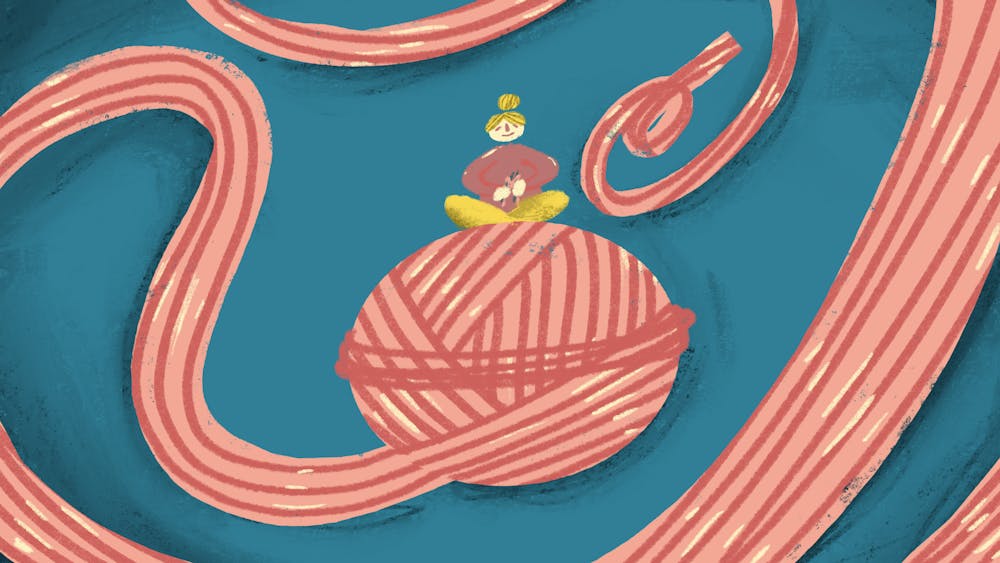I grew up in a household where threads and crochet needles were omnipresent—nestled in the creases of the sofa, strewn across the kitchen table, and even making their way into the bedrooms. My mother is a natural crocheter. Over the years, I've carried her crochet legacy with me, even during my time at Penn. Her work has served multiple purposes in my life, from bikini tops on family vacations to protective crochet Kindle cases and cozy rugs for my dorm.
Whenever someone questioned my mom's love for crochet, she'd promptly say, “It's an ancient art!” And she was not wrong. The history of crochet follows the history of civilizations. The craft has gone through wars and revolutions and traveled to the four corners of the world, but the origins of this ancient art are still uncertain. Crochet, as we know it today, has its roots in the 16th century, and one of the most accepted theories shows that it began in the Middle East, reaching the whole world through Mediterranean trade routes.
Even though it is an old form of art, crochet is more modern than ever. From the coveted Prada Crochet Tote Bag that graces the arms of fashion–forward trendsetters to the crochet summer dresses that have become staples of warm–weather wardrobes, crochet is experiencing a renaissance on the runways and in everyday wear.
Now, crochet has found a new platform to flourish, especially among young and creative individuals. What was once considered a traditional craft has evolved into a thriving untraditional online community. Mahum (@mahumcrochets), a young crochet enthusiast, boasts an impressive following with 254.2K TikTok followers and 312K YouTube subscribers. Beyond her digital presence, Mahum is actively involved in promoting the accessibility of crochet art. She dedicates her time to teaching crochet courses for young children and teenagers at an independent art studio, fostering a new generation of craft enthusiasts.
In a YouTube video titled “How Crochet Changed My Life,” she says, “When I first came to Dubai and moved into my student dorm, I was aimless and directionless. I had no purpose, and I didn't know what to do with myself. From September to December, I did not leave my room except to go to university. But during that time period, I completely made a life for myself. I would say, in this room, spending hours constantly working on my crochet pieces.”
Crochet can be more than just a hobby—it can also serve as a source of income. Social media platforms, online marketplaces, and crafting websites have provided many teenagers with the tools to turn their crochet creations into profitable ventures. Young crocheters are leveraging their skills to sell handmade items, share tutorials, and connect with a global audience.
The appeal of crochet as a source of income lies in its versatility. From fashion accessories and home decor to amigurumi (the Japanese craft of crocheting small stuffed toys) and custom designs, the possibilities are endless. This wide range allows young crocheters to tap into niche markets and cater to diverse customer preferences. Also, the rise of sustainable fashion movements has further fueled the demand for homemade products. Consumers are increasingly drawn to unique, eco–friendly, and personalized items.
An example of this close–knit community at Penn is the Kelly Writers House Fiber Arts Circle, which welcomes anyone interested in crafting or learning fiber arts every Sunday—no experience necessary. Zuza Jevremovic (C '26), an active participant in the club, mentions how “the great thing about the KWH Fiber Arts Circle is its availability to all manner of fiber arts.” They also have a budget for members' personal projects and occasionally take trips to local fiber–arts–interest shops like Wild Hand.
They are currently working on a community blanket project. According to Zuza, “helping to contribute to such an artwork is a great source of motivation to create.” Her interest in crochet began “in the home-bound dullness of quarantine” and grew up into a bigger part of her life, signifying even an income: “It does mean a lot to have someone purchase something you created.”
Crochet has many benefits. Researchers have presented evidence that engaging in crafting activities can have benefits for emotional health. As Zuza says, “Put your fingers on some Bernat blanket yarn and see if it does not immediately improve your state of mind.” Crocheting, in many ways, mirrors some of the positive effects attributed to meditation, acting as a natural antidepressant. Studies have gone so far as to conclude that regular participation in crafting may serve as a potent defense against cognitive impairment.
This revival of crocheting stands as a testament to the power of craft and creativity in our increasingly fast–paced world. It reminds us that the simplest of art forms can provide solace in times of distress, offer an unexpected means of income, and bring people together, where connections are woven one stitch at a time.







